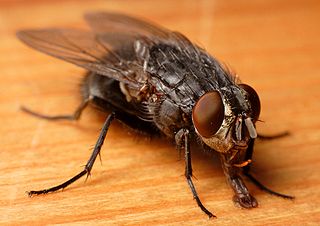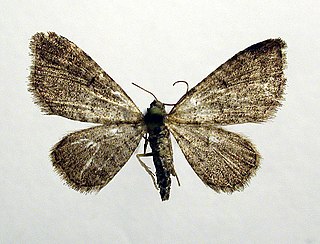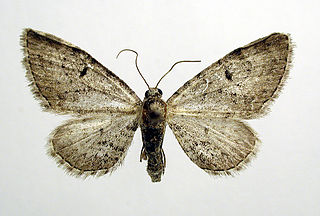
Eupithecia is a large genus of moths of the family Geometridae. There are hundreds of described species, found in all parts of the world, and new species are discovered on a regular basis.

The wormwood pug is a moth of the family Geometridae. The species was first described by Carl Alexander Clerck in 1759. It is a common species across the Palearctic region as well as North America.

The common pug(Eupithecia vulgata) is a moth of the family Geometridae. It is a common species across the Palearctic region, including the Near East and North Africa. It ranges from the Atlantic coast of Ireland and Portugal across Europe, the Middle East and Central Asia to the Russian Far East (Priamurje) and Korea.

The grey pug is a moth of the family Geometridae. It is found throughout the Palearctic region. It is also found in North America.Since it does not place any special demands on climatic conditions, special caterpillar food plants, geological subsoil or the like it is a typical species of almost any Hochstaudenflur, where it occurs in the herb layer, in bushes and even on deciduous trees. It can be found on forest edges and hedgerows, on heath, in rocky places and wetlands, parks and gardens, as well as in villages and town centres.

The juniper pug or juniper looper is a moth of the family Geometridae. The species was first described by Michael Denis and Ignaz Schiffermüller in 1775. It is found throughout the Palearctic and in the Nearctic.

Pantelleria Airport is a regional airport on the Italian island of Pantelleria. It is located 5 km from the town centre and features both regular and charter flights from and to Sicily and mainland Italy.
The Tagula honeyeater is a species of bird in the family Meliphagidae. It is endemic to Papua New Guinea.

Calliphora vicina is a member of the family Calliphoridae, which includes blow flies and bottle flies. These flies are important in the field of forensic entomology, being used to estimate the time of a person's death when a corpse is found and then examined. C. vicina is currently one of the most entomologically important fly species for this purpose because it arrives at and colonizes a body following death in consistent timeframes.

Eupithecia plumbeolata, the lead-coloured pug, is a moth of the family Geometridae. The species can be found all over Europe ranging to the Urals, then through Central Asia to Siberia and to Sayan mountains, the Altai and the Amur. In the Alps, the species occurs up 2000 metres above sea level and in the Pyrenees up to in 2400 metres.

Eupithecia venosata, the netted pug, is a moth of the family Geometridae. It was first described by Johan Christian Fabricius in 1787. It is found across the Palearctic realm from Portugal and Morocco in the west to the Lake Baikal in Siberia and Afghanistan and Pakistan in the east.

Eupithecia satyrata, the satyr pug, is a species of moth of the family Geometridae. It was described by Jacob Hübner in 1813. It is found from Ireland, through northern and central Europe east to all of Russia and central Asia and western Siberia to Tibet. It is also present in North Africa and North America.

Eupithecia pimpinellata, the pimpinel pug, is a moth of the family Geometridae. The species was first described by Jacob Hübner in 1813. It is known from most of Europe to Morocco, Siberia, Kyrgyzstan, Altai, Mongolia.It primarily colonizes bushy places, forest edges, clearings, hedges, mountain slopes, embankments, railway dams and parks as well as semi-dry grasslands. In the Alps it rises to heights of 1800 metres.

Vicina was a town on the Danube used as a tradepost (Emporia) by the Republic of Genoa, being part of the Genoese trade empire between the 13th and 14th century. At one time, it was the most flourishing port of the maritime Danube, but its importance declined with the development of other ports such as Kilia and Brăila. Although many locations have been proposed by both historians and archeologists as the remains of Vicina, it is still unknown where this town was located.
Caradrina vicina is a moth of the family Noctuidae. It was described by Staudinger in 1870. It is found from Central and Southeastern Europe, eastern and central Anatolia, and Western to Central Asia. The habitat consists of grasslands.

Agelaia vicina is a species of wasp in the genus Agelaia. They are neotropical social wasps known to have the largest colony sizes and nest sizes among social wasps, with some colonies exceeding over one million individuals. They are predators of land arthropods, consuming both insects and spiders alike. Recent sperm morphology studies have shown that although Vespidae belong to the superfamily Vespoidea, Agelaia vicina may be more phylogenetically related to Apoidea.

Chelonoidis vicina, commonly known as the Cerro Azul giant tortoise, Iguana Cove tortoise or the Isabela Island giant tortoise, is a species of Galápagos tortoise endemic to Isabela Island in the Galápagos.













